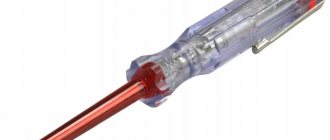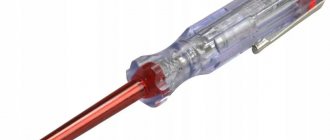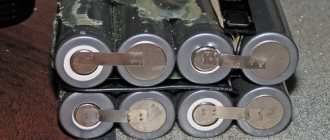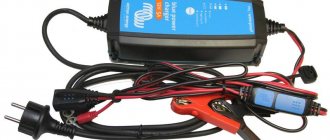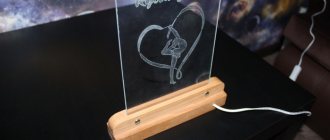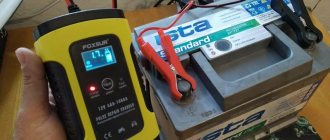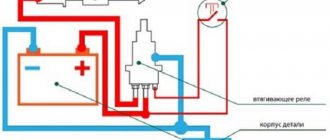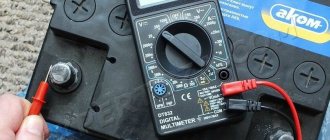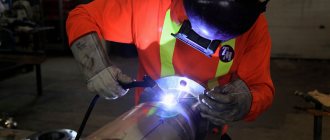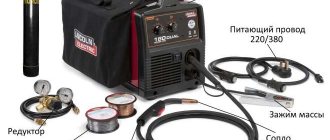Tips for builders | 03/02/2017
Anyone who often works with small screws or self-tapping screws has encountered the fact that at the most inopportune moment, the fastener inevitably falls. And it would be fine if it just fell, but no - it flies to the side and completely disappears from sight. After a dozen such accidents, work ceases to be enjoyable and the mood quickly deteriorates. And to prevent this from happening, today we will learn how to magnetize a screwdriver at home and talk about special magnetizers for screwdrivers.
We create a device for demagnetization with our own hands
To do this, you will need a spool of wire that can withstand 120-127 volts and a powerful step-down transformer.
The structure is assembled according to the following scheme. Wind the wire around the coil of the transformer and connect it to it. After this, a screwdriver is placed in the internal cavity of this coil and alternating voltage is applied.
If you have an old unnecessary TV, you can assemble a device with your own hands, which includes a kinescope demagnetization loop (it is located around it). Connect its ends together to form a circle and wrap it with electrical tape, leaving two wires outside.
Attach the resulting structure to a block of wood, which will serve as a handle. Using a button from any power tool, connect two wires to a 220 volt network.
Important! Be sure to insulate all wires and contacts to prevent electric shock!
The device is ready for use. Turn it on and place a screwdriver in the ring. Hold it for no longer than 5 seconds, then turn off the device, otherwise it may overheat.
There are a huge number of ways to demagnetize a screwdriver at home, so you can choose any one you want.
https://youtu.be/https://www.youtube.com/watch?v=kOjFtJ87nK4
_
Useful DIYs
How to magnetize any tool, simple instructions.
How can you magnetize or demagnetize an iron object, tool, part » about the effect of magnetism
This is an old magnetic grip, it has long been demagnetized, and can barely hold even a small screw. In this tutorial I will show you how very easy it is to remagnetize an old magnet without changing its polarity. By the way, you can magnetize almost any metal tools in the same way. The same screwdriver is a hundred times more convenient to work with when it is magnetic, and there is no need to hold the screw with your second hand.
Materials: Any copper wire insulated with electrical tape
Tools: Flat screwdriver Magnetic compass DC power supply, batteries or rechargeable batteries.
We wind the insulated wire around the place where the magnet is located. If you don't have an insulated wire, an enameled one will work too. Just in case, I wound it almost the entire length of the gripper shank, although it is obvious that the magnet itself is shorter than it. You can see for yourself how simple it is, I do everything by eye, I don’t count the turns of wire, and I decided to wind three layers.
I want to strengthen the magnet, so I have to demagnetize it to zero, and then increase it in reverse polarity. An ordinary compass will help us find out the polarity of the magnet. I positioned the compass so that it was not in the north-south axis, then I brought the magnet closer to the compass, and it attracted the south pole of the magnet in the compass.
After this, you need to figure out which wire of the coil to feed the plus, and which – the minus. To do this, I removed the coil from the grip shank and put it on a screwdriver of a slightly smaller diameter, so that the coil can be easily removed and put on, it needs to be re-wound a little with electrical tape. By the way, this is exactly how you can magnetize the screwdriver itself. To avoid confusion with wires, I made one wire long and the other short. Well, after I put the coil on the screwdriver, all that remains is to bring it to the compass and connect the wires to the battery in such a polarity that the screwdriver attracts the south pole of the magnet.
Next, I removed the coil from the screwdriver and returned it to the shank of the magnetic gripper, so that the shorter wire was closer to the front end of the gripper, as it was on the screwdriver in the previous step. I used two old flashlight batteries to power the coil and held the coil wires with my hand for a couple of minutes. This time turned out to be quite enough, 3 volts also turned out to be quite enough to magnetize the grip quite well.
Checking the magnetic grip: holds better than new!
You are unlikely to need magnets for the rivet maker, but you can purchase consumables, 5 mm rivets, as well as rivets of any other sizes on our website.
More interesting DIY videos:
- How to refill a printer cartridge
- Homemade antenna
- Rabbit made of polymer clay as a stand..
- How to make a metal ruler
- Homemade Decorative Photo Frame
- A few examples of homemade boxing weights...
Subscribe
0 Comment
Intertextual Reviews
View all comments
What other ways are there?
If you have a round magnet with a hole in the middle in your house, you can use it to demagnetize a screwdriver.
To do this, simply thread the screwdriver through the magnet, starting from the tip and ending with the bottom of the handle. This action is performed at a leisurely pace. As a rule, one time is enough to demagnetize, but you can repeat it if necessary.
If there is no hole or it is not wide enough, there is a second method. Position the screwdriver in relation to the magnet at the minimum distance at which it is not attracted to it. Then, making small “oscillatory” movements, move it from one pole to the other, gradually moving away from the center. The further away it is, the less vibration should be. After this it should demagnetize.
For the third method we will need a magnetometer. First, determine the level of magnetic field strength of the screwdriver. Then find a field with the same voltage on the magnet, but at a pole with the opposite sign. After that, all you have to do is press the screwdriver exactly to this part.
Using a demagnetization device
The demagnetization device comes in three variations. The basic elements can be selected at home, using simple methods that do not require much effort to manufacture. There are special devices that can both demagnetize and magnetize an element.
Magnetometer
Magnetometers are used in the following sequence:
- The magnetic field strength of the instrument is an important parameter that needs to be determined, because it is possible to get a negative result;
- the same parameter must be found on a magnet of the opposite sign;
- touching the tool to the area of the device will demagnetize it.
The process takes place within 10 seconds; at home, no connection to the electrical network is required. The functionality is checked as follows: the self-tapping screw is brought to the magnetized metal, and the level of magnetization is checked. Afterwards the demagnetization process occurs and is checked again.
How to magnetize a screwdriver without a magnetizer?
It is clear that buying a special magnetizer is not always justified, especially if work with fasteners is carried out infrequently. In such cases, the question arises: how to magnetize a screwdriver using improvised means? If you have a relatively powerful magnet, you can run it several dozen times along the metal part of the screwdriver, starting from the middle to the tip. You need to do it in such a way as not to touch areas close to the handle. Sometimes, if magnetized instruments are constantly needed, they are simply kept “stuck” to a powerful magnet. This is usually sufficient. You should not use a magnet that is too powerful - breakdowns and strong interference, especially when working with electronics, can cause serious problems.
Unfortunately, if you need a screwdriver with a magnetized tip urgently, it can be difficult to find a sufficiently powerful magnet nearby and, even more so, a screwdriver magnetizer. In this case, you can remember that you can make an electromagnet from scrap materials. And with its help, magnetizing any steel object, for example, a screwdriver, will not be difficult.
One of the simplest methods: several hundred turns of varnished copper wire are wound on a screwdriver wrapped in paper. The coil thus obtained is supplied with voltage from a battery or battery (you can use a charger). A voltage of 5 or 12 volts is enough to magnetize any object inside the coil at home. You can make a more powerful electromagnet or restore the lost properties of a factory magnet (by placing it in a magnetic field) using the same method, only you need to make a larger number of turns on the coil.
They also use household voltage. In this case, a small fuse or a section of thin wire (0.1–0.15 mm in diameter) is connected to the coil, which also serves as a fuse. When you connect the coil to an outlet, the fuse will burn out (you should be careful, it is advisable to cover the fuse or a thin section of the wire with paper or something similar), but the powerful electromagnetic field will have time to give the metal inside the coil magnetic properties.
It is clear that experiments with life-threatening voltages should only be carried out if you are completely sure of the possible consequences. It is probably safer and more reliable to buy a screwdriver magnetizer and keep it at home or at work. In addition, be sure to remember that when working with computers or any other electronics, highly magnetized screwdrivers can do more harm than good.
How to magnetize a bat yourself
If you don’t have special magnetic attachments, adhesive tape, or electrical tape at hand, then in this case you can try to magnetize the bat yourself at home. To do this, you need to take two magnets (preferably neodymium) and place a bat between them. It’s worth noting right away that this is a very lengthy process that takes a lot of time.
You can use a battery to magnetize the bit. To do this, you need to take a piece of copper wire, remove the insulation from it and wrap it in small turns along the bit. Then the edges of the wire need to be connected to the battery, after which the bit will begin to be magnetized. However, it should be noted that in this case the magnetization effect will last a short time.
It is worth noting that today there are special devices on the market that allow you to magnetize a variety of objects and hand tools. In addition to bits, such devices are perfect for magnetizing screwdrivers. Their advantages include the fact that they almost instantly magnetize any metal object.
There are several different methods and life hacks that allow you to screw self-tapping screws into hard-to-reach places, holding them directly on the screwdriver bit, preventing them from constantly slipping off. However, if you don’t have special magnetic attachments at hand, it is inconvenient to constantly use adhesive tape or electrical tape (after all, when carrying out complex work, when you need to screw in a large number of screws, constantly wrapping them with electrical tape is very problematic). In this case, you can take two small magnets, for example from the cheapest Chinese headphones, and attach them to the surface of the bat. After this, a magnetic field will appear that will not allow the screw to break off.
Alternatives to neodymium magnets and commercial magnetizers
If you don't want to go to the store to buy a magnetic screwdriver or screw drill, it's unlikely that you'll want to make a trip to buy a neodymium magnet or commercial magnetizer. No problem. You probably have magnets around the house that will work just as well. Here are some places to look:
Any of these fun decorations attached to your refrigerator can magnetize your screwdriver.
- Objects stuck to refrigerator doors often have magnets strong enough to do the job. The harder it is to get an object out of the refrigerator, the better it will work.
- Audio speakers are built with strong permanent magnets. If you can access the back of the speaker, rub the screwdriver shaft along the flat part where the speaker wires are attached. For safety reasons, be sure to disconnect the wires first.
- Kitchen and bathroom cabinets often have magnetic latches. Rub a screwdriver along one of these magnets to magnetize it.
- Your battery drill may have a magnetic screw holder on the base. This magnet should be strong enough to magnetize your screwdriver or threaded head.
tips
Using a steel alloy drill bit in combination with a magnetic holder will magnetize the drill bit and it will remain magnetized even if you use it without a holder. The field wears off after a few months - sooner if you drop a screwdriver or hit it with a hammer. When the screwdriver becomes demagnetized, use it with the holder or rub it with a magnet to turn it back on.
How to magnetize a screwdriver?
If you're tired of losing screws, simply magnetize your screwdriver. Honestly, every tool like this should be magnetized, but unfortunately it is not. Fortunately, correcting such an omission is very simple. However, it is important to have a strong, large magnet. And as soon as you bring it to your screwdriver, an attractive effect will appear that will last for many years.
So what is the magnetization process and how does it work? The basic principle is the alignment of iron atoms in one specific direction, which causes repulsion or attraction. Therefore, the strength of the magnet depends on the iron content of the product.
An alien world could be locked underground, scientists say
How to make delicate sweets with tiramisu flavor from rice flour and mascarpone
Russians broke the record for the number of holidaymakers in Turkey
Magnetizer for screwdrivers and more
The magnetic properties of the tool make life much easier. There is confidence that not a single screw, even the smallest one, will fall out or get lost. In any case, it will remain at the tip of the tool.
But there are also situations when this turns into a “disservice”. If you work with electronics, a magnetized tool can have a negative impact. This led to the invention of the so-called magnetizer.
The operating principle of this device is very simple, but nevertheless very effective. It allows you to quickly endow any screwdriver with the properties of a magnet, and, if necessary, get rid of this effect. The device, which is very simple in design and principle of operation, allows you to magnetize the tip:
- screwdriver;
- scissors;
- self-tapping screws;
- screws;
- screws
Essentially, any metal object can be given magnetic properties. Due to the fact that the device does not require the use of an electrical network or additional charging, it can be used in any conditions. The compact size also contributes to this to a large extent. In this case, you do not need to have any special knowledge or skills.
The body of the structure consists of polymer. Two magnets are placed inside. Two holes on the body allow you to impart magnetic properties or, conversely, demagnetize. In order not to confuse which one is intended for what, all holes have corresponding markings.
If you place a screwdriver or other metal object inside the corresponding hole, it will be magnetized. If these magnetic properties are no longer needed, the object is placed in another hole. If, apart from screwdriver bits, nothing else needs to be magnetized, then you need to purchase a device that has small slots. This is why the cost changes.
In addition, a small hole affects the proximity of the magnets, and, accordingly, the strength of their influence. The reverse is also true: a larger tool or fastener will require a device with larger holes.
In fact, the entire device is a small piece of plastic with two holes, and sometimes with one or two magnets. Small size, light weight - all this allows the device to be used not only in the workshop, but also to be easily transported. The cost of the product is low, usually no more than six hundred rubles, but some models cost much more.
Magnetizer/demagnetizer for screwdrivers/bits and other tools
This magnetizer is supplied without any folded packaging. It came to me in a regular plastic bag.
What was surprising was that after removing it from that same bag, the device did not emit any unpleasant odor. I cannot say anything more or less objective about the quality of its production due to the fact that it is very difficult to evaluate it. The body of the device is made of plastic to which there are no special complaints. The letters on the body are worn out in places, and glue oozes out from the joint of the two halves. But in general, everything is fine, and this is a rare case when the quality of workmanship does not in any way affect the performance of the device
The weight of the device is 71 grams.
And its dimensions are 5 x 4.5 x 2.5 centimeters, so it can easily fit in any tool box.
The design of the device is extremely simple - in its lower part there is a rectangular hole marked “MAGNETIZER”. A metal object placed inside this hole is exposed to magnetic fields, which give it the ability to attract metal. At the top of the device there is a hole, one edge of which is made of a ladder. It is designated as “DEMAGNETIZER”. As you may have guessed, if you place a metal object here that has the ability to attract metal elements, it will lose it. Through trial and error, it was found that to achieve the best effect, it is not enough to simply place a metal object in a particular hole; you also need to rotate it around its axis so that the magnetization/demagnetization is uniform.
The internal structure of the device is even simpler than the external one - there are only 2 magnets
By the way, if you turn them over, the magnetizer loses its abilities. And yes, you need to disassemble the case carefully, and not like me - my plastic guides were cracked
It is difficult to photograph the operation of the magnetizer, so I decided to capture it on a short video. At the beginning of the video, we demagnetize and magnetize a screwdriver with a magnetic tip, and in the second part we give a regular screwdriver the ability to magnetize screws/bolts.
As you can see, everything works, and very well. The demagnetization process takes longer than the magnetization process, but this does not in any way affect the performance of the device as a whole.
You can argue for a long time about the advisability of making such a purchase and the advisability of this device in general, but I want to tell you that with a magnetized screwdriver it is much easier to screw in (insert into deep holes) screws, and when unscrewing them you don’t have to worry about it falling and getting lost - the screw will hang on the tip of the screwdriver. In general, I am completely satisfied with the purchase - for little money I got a fun little toy that works, and does it well. Whether it is needed in the household or not - everyone decides for themselves.
That's probably all
Thank you for your attention and your time
How to demagnetize using the device
It is impossible to completely remove the magnetic properties of a metal product. You can only reduce its magnetism to such an extent that chips and small parts do not stick
This is important to consider when repairing electronics.
For such a decrease (or, conversely, an increase, if necessary), there are special demagnetizers, which can be purchased at repair stores or companies selling tools. They are inexpensive and look something like this:
As you can see, everything is simple: two spaces, the upper one demagnetizes, the lower one, on the contrary, magnetizes. The tool is placed into the desired area and held there for about ten seconds, after which it is ready for use.
There are different sized models of such devices: from pocket-sized ones - for small tools, to huge ones - for use in industrial conditions. Accordingly, they differ in the power of impact.
What makes such a pocket-sized device convenient is that it does not require connection to anything - it is always ready to use. It’s easy to check its effect even in a store: you just need to take a screwdriver and some small part, for example, a nut, and conduct an experiment. After magnetizing the screwdriver, the nut should be easily attracted to it, and after demagnetization it should not “stick” even with close contact.
Demagnetize the screwdriver
But unfortunately, there are situations in which it would be better if the screwdriver were not magnetic. After all, if you put it on the table, then it can collect all sorts of little things around itself, from which it will then take a long time to clear the tip in order to start working at the right and crucial moment. In such a situation, you can demagnetize the screwdriver at any time
This procedure requires a round magnet with a hole in the middle. Such magnets are used in speakers, so finding them is not difficult. In the garage of every motorist there is an old and not working pump, which can always be disassembled for spare parts.
But here the main thing is to act carefully and try to insert the back of the screwdriver into the hole in the magnet without touching the walls. Doing this is not as difficult as it seems at first glance. No explosion or short circuit will occur, so if you fail the first time, you can try again until the back of the screwdriver is completely immersed in the core of the magnet.
But there are some subtleties here too. You need to take only intact magnets that do not have any cracks or other defects. Otherwise, nothing will work out, and the screwdriver will remain magnetic, which on the one hand is not so bad. Perhaps this is due to the magnetic fields that are closed in a magnet with a solid circle, but be that as it may, the result is obvious.
By the way, you can use this technique to quickly demagnetize turning tools. If they need to be sharpened, then the magnetic properties will not allow you to achieve the most accurate result, since during sharpening, all the chips and fine dust will be magnetized to the base.
Therefore, if you decide to disassemble or simply throw away old speakers or just speakers, then you should think about whether you feel sorry for throwing away such a useful magnet? It's best to pull it out and leave it until better times. A magnet will never be superfluous in the household. Even if you have a lot of them, you can use one to collect metal shavings from the floor after work.
Magnetize the screwdriver
In fact, there is nothing unusual or supernatural here. In order for the screwdriver to become magnetized, simply touch the very tip to the surface of the magnet. All this can be done in a matter of seconds, and a previously simple screwdriver can instantly turn into the newfangled magnetic model itself.
Now you can easily remove small nails or screws from a jar of nails and not worry about them scratching or pricking you. This is convenient, because if you are holding a shelf against the wall with one hand that needs to be screwed, and the screw has fallen, you can only lift it by touching it with the tip of a screwdriver.
A magnetized screwdriver can serve as an elongated magnet if a bolt or nut falls onto the protection during car repairs. It will be almost impossible to get there by hand, but with a screwdriver you can reach almost any part of the protection.
Magnetic attachments
Most craftsmen who have, even if not much, experience working with self-tapping screws, know that there must be special magnetic attachments for bits at home. Thanks to the use of such attachments, the screw is held on the surface of the bit even in the case of complex work, at a large angle of inclination.
Finding such magnetized attachments is easy; they are sold in almost every hardware store or online store. The average cost of such attachments is about 60 – 80 rubles per piece. It is best to purchase a set of magnetic screwdriver attachments for home or professional use.
Making a magnet at home
Man first became acquainted with magnets in ancient times. However, very quickly this natural stone ceased to satisfy people's needs. It was then that the technology for making magnets was developed. Of course, a lot of time has passed since then.
Technology has changed significantly, and now it is possible to make a magnet at home. You don't need any special skills or knowledge to do this. It is enough to have all the necessary materials and tools at hand.
So, making a magnet looks like this.
Soft magnetic materials
All materials capable of magnetization can be divided into soft magnetic and hard magnetic. There is a significant difference between them. Thus, soft magnetic materials do not retain magnetic properties for long.
You can conduct an experiment: run iron bars over a strong magnet several times. As a result, the material will acquire the properties of attracting other metal objects. However, the manufacture of a magnet that constantly possesses these abilities is impossible in this case.
Hard magnetic materials
Such materials are obtained by magnetizing an ordinary piece of iron. In this case, the properties are preserved much longer. However, they completely disappear when the object hits a sufficiently hard surface. Also, the magnetic properties are destroyed if the material is heated to 60 degrees.
What you will need
Making magnets with your own hands will not take much time and will not require any special expenses. For this you need:
- screwdriver;
- oiled paper;
- fuse;
- switch;
- copper wire;
- the strongest permanent magnet.
Method one
This method is considered the simplest. It is enough to hold a magnetized object several times in one direction against a permanent strong magnet. That's all.
However, it should be taken into account that magnets made using this method do not hold a magnetic field for long and very quickly lose their properties. Such products are suitable only for simple manipulations.
For example, such a magnet can help remove a needle that has fallen out of a crack or tighten bolts, but nothing more. Therefore, this method should not be seriously considered.
Let's look at an example with a screwdriver. To begin with, the tool should be wrapped in an insulator, and then wound about 300 turns of wire. It is better to use the one that is used for the manufacture of transformers. After this, the wire must be connected to a battery or battery, preferably 5-12 volts. As a result of such manipulations, the electromagnetic field will magnetize the screwdriver.
Method three
Making a magnet may seem like a daunting task. Since the above methods do not guarantee that the properties will be maintained for a long time. A stronger magnet can be created using an inductor coil.
The metal blank must be small, since it will need to be placed inside the coil. After this, you should follow exactly the same procedure as indicated in the previous method. The only difference is that you need to make twice as many turns of wire, that is, 600.
Only in this case can a good magnet be obtained.
Method four
The manufacture of a magnet in this case involves the use of current from the electrical network
This method is quite dangerous, so all manipulations should be performed carefully and carefully. We need a fuse, without which nothing will work
It must be connected in series with an inductor coil, inside of which there is a metal workpiece.
Of course, when such a design is connected to the network, the fuse will blow. However, during this short period of time, the metal workpiece will have time to charge, since in this case a fairly strong electromagnetic field is created. Here it is worth considering one nuance: the higher the current strength, the stronger the magnet will be. To wind the coil you should use only copper wire.
Finally
Making permanent magnets at home is a fairly simple process. However, you should be careful when using certain schemes.
Neodymium is considered the most powerful permanent magnet. You can make it at home, but this requires a piece of rare earth metal - neodymium. In addition, an alloy of boron and iron is used. Such a workpiece is magnetized in a magnetic field. It is worth noting that such a product has enormous power and loses only 1 percent of its properties over a hundred years.
The main reasons for metal magnetization
Magnets are media that create their own magnetic field. Main groups of magnets:
- paramagnetic materials;
- ferromagnets;
- Diamagnets.
Steel products based on alloys of iron, cobalt or nickel refer to substances whose own magnetic field is higher than the external one, i.e. to ferromagnets. The magnetization of a substance is considered to be the sum of the magnetic properties of particles per unit volume.
At the moment the Curie temperature threshold is reached, spontaneous domains with magnetization are formed, which spread until they are completely filled. Under normal conditions, it is possible to obtain a magnetized tool when working close to electric motors, magnetrons and other elements. The metal takes away the properties of magnetism from a nearby emitter, thereby becoming magnetized.
Working with small parts with a magnetized tool can cause a lot of trouble. Sharpening metals with increased magnetism properties is impossible to ideal sizes, because... the material is covered with shavings.
DIY degausser
Craftsmen when working with various metals are faced with a problem - magnetization of tools.
In some jobs, magnetic properties help with actions, for example, with a magnetic screwdriver you can install a screw in a hard-to-reach place.
The build-up of metal shavings when using a caliper, file or drill can interfere with marking or a straight cut line.
How to demagnetize metal at home
The main reasons for metal magnetization
Magnets are media that create their own magnetic field. Main groups of magnets:
- paramagnetic materials;
- ferromagnets;
- Diamagnets.
Steel products based on alloys of iron, cobalt or nickel refer to substances whose own magnetic field is higher than the external one, i.e. to ferromagnets. The magnetization of a substance is considered to be the sum of the magnetic properties of particles per unit volume.
At the moment the Curie temperature threshold is reached, spontaneous domains with magnetization are formed, which spread until they are completely filled.
Under normal conditions, it is possible to obtain a magnetized tool when working close to electric motors, magnetrons and other elements.
Magnetized screwdriverMagnetized paper clip
Working with small parts with a magnetized tool can cause a lot of trouble. Sharpening metals with increased magnetism properties is impossible to ideal sizes, because... the material is covered with shavings.
Using a demagnetization device
The demagnetization device comes in three variations.
The basic elements can be selected at home, using simple methods that do not require much effort to manufacture.
There are special devices that can both demagnetize and magnetize an element.
Magnetometer
Magnetometers are used in the following sequence:
- The magnetic field strength of the instrument is an important parameter that needs to be determined, because it is possible to get a negative result;
- the same parameter must be found on a magnet of the opposite sign;
- touching the tool to the area of the device will demagnetize it.
The process takes place within 10 seconds; at home, no connection to the electrical network is required.
The functionality is checked as follows: the self-tapping screw is brought to the magnetized metal, and the level of magnetization is checked.
Afterwards the demagnetization process occurs and is checked again.
Methods for demagnetizing metal
There are several ways to demagnetize metal structures.
Devices are used depending on the frequency of use, purpose and power.
Before you demagnetize metal at home, you need to understand the existing structures.
- An ordinary magnet is large in size; a tool is held over it at a minimum distance, on the verge of the attraction process. The magnet can be removed from an old speaker, most of which are round in shape. The process is carried out when the product is removed from the structure, loosening it; the further the tool is from the structure, the smaller the amplitude. The location of the axis on which there is no magnetic field depends on the design of the product.
- More frequent use will require a device operated at home from the mains. It is possible to make the device at home or purchase it at radio parts stores. The main component is a coil of wound wire connected to a transformer. The supply of alternating current allows you to demagnetize the element, direct current - vice versa.
Removing magnetization with a magnetometer
There are many variations and kits for demagnetizing metals in production.
Tunnel devices include a coil having an opening connected to a network.
The size of the hole can be different, depending on the purpose and dimensions of the parts being processed.
Multi-band magnets driven by motion, rotation of which occurs with speed control, the impact and change in amplitude is carried out by moving the part away from the body.
Electromagnets operate from a 220 or 380 volt network and allow you to demagnetize an element with a tap for a certain time. Container mechanisms allow you to install the product to a device in which the necessary environment is automatically created.
Screwdriver magnetizers
Sometimes it is much more convenient to work with a magnetized tool; there is no need to worry that some screw or screw will fall - it remains hanging on the end of the bit or screwdriver. However, in some cases, excessive magnetization is harmful - this can be confirmed by any technicians who often have to open computer system units or laptop cases. When working with computer components, too much magnetization can cause harm. Therefore, today quite often a simple and effective device has begun to be used - a screwdriver magnetizer. It can quickly magnetize a regular screwdriver or, if necessary, also quickly demagnetize it.
A simple device in design and use, the screwdriver magnetizer is designed, as the name implies, to magnetize the ends of screwdrivers, scissors, and other metal objects, including fasteners (self-tapping screws, screws). The device is self-contained and does not require a connection to the network or charging; it can be useful for any type of activity that requires working with fasteners. To use this device you do not need skills or any special knowledge.
The design is very simple - there are two magnets in a polymer case. In the same body, two slots are made, one for magnetization, the second, on the contrary, for demagnetization. The slots are usually signed or marked. In order to give the end of a screwdriver or other object magnetic properties, it is enough to place it in the appropriate slot for a while. To demagnetize, an object is placed in another.
If you plan to work only with bits or something similar, you should purchase a screwdriver magnetizer with narrow slots. The end of a screwdriver or bit can easily fit into them, and due to the short distance to the magnet, more effective action is possible. If there is a possibility that you will have to magnetize other types of tools (scissors, pliers or tweezers) or slightly larger fasteners, then you should prefer a device with wider windows. It will be easier to place the part intended for magnetization into it.
The screwdriver magnetizer looks like a small plastic block with two or even one slot (demagnetization occurs in a groove on the top of the body). Small in size and weight, the device also has a low price - the device is sold for 100–400 rubles, although there are options for 1–1.3 thousand rubles.
https://youtube.com/watch?v=WkCwAvij1Z0%3F
How to magnetize a screwdriver?
Anyone who often works with small screws or self-tapping screws has encountered the fact that at the most inopportune moment, the fastener inevitably falls. And it would be fine if it just fell, but no - it flies to the side and completely disappears from sight. After a dozen such accidents, work ceases to be enjoyable and the mood quickly deteriorates. And to prevent this from happening, today we will learn how to magnetize a screwdriver at home and talk about special magnetizers for screwdrivers.
Screwdriver magnetizers
Sometimes it is much more convenient to work with a magnetized tool; there is no need to worry that some screw or screw will fall - it remains hanging on the end of the bit or screwdriver.
However, in some cases, excessive magnetization is harmful - this can be confirmed by any technicians who often have to open computer system units or laptop cases. When working with computer components, too much magnetization can cause harm.
Therefore, today quite often a simple and effective device has begun to be used - a screwdriver magnetizer. It can quickly magnetize a regular screwdriver or, if necessary, also quickly demagnetize it.
A simple device in design and use, the screwdriver magnetizer is designed, as the name implies, to magnetize the ends of screwdrivers, scissors, and other metal objects, including fasteners (self-tapping screws, screws). The device is self-contained and does not require a connection to the network or charging; it can be useful for any type of activity that requires working with fasteners. To use this device you do not need skills or any special knowledge.
The design is very simple - there are two magnets in a polymer case. In the same body, two slots are made, one for magnetization, the second, on the contrary, for demagnetization. The slots are usually signed or marked. In order to give the end of a screwdriver or other object magnetic properties, it is enough to place it in the appropriate slot for a while. To demagnetize, an object is placed in another.
If you plan to work only with bits or something similar, you should purchase a screwdriver magnetizer with narrow slots. The end of a screwdriver or bit can easily fit into them, and due to the short distance to the magnet, more effective action is possible.
If there is a possibility that you will have to magnetize other types of tools (scissors, pliers or tweezers) or slightly larger fasteners, then you should prefer a device with wider windows.
It will be easier to place the part intended for magnetization into it.
The screwdriver magnetizer looks like a small plastic block with two or even one slot (demagnetization occurs in a groove on the top of the body). Small in size and weight, the device also has a low price - the device is sold for 100–400 rubles, although there are options for 1–1.3 thousand rubles.
How to magnetize a screwdriver without a magnetizer
As in the case of a special screwdriver, a magnetizer can become unnecessary and an unjustified waste of money and time. This is especially true in cases where the need for a magnetized screwdriver is extremely rare.
And then there is a need to find a handy way to solve the problem. There are several methods on how to magnetize a screwdriver at home without using the device described above:
Using a powerful magnet. If there is such an item, then you can bring the instrument to the desired state in a few minutes. You need to move the screwdriver from the tip to the middle with a magnet. If you always need such a tool, then after work you can leave it on the magnet.
Using an improvised reel. In cases where there is no good magnet, and you need a screwdriver right now, you can make the missing item yourself. To do this, you need to wrap a metal object with paper and varnished copper wire.
For a good result, the wire will need a lot, two to four hundred turns around the selected object. The result is a coil to which voltage must be applied. To do this, you can use a battery, batteries, charger, and so on.
Through the voltage of the household, general power supply network. The same coil is also used here, only the voltage is supplied from the outlet
An important difference is the presence of a fuse that can protect against short circuits. You should be especially careful, because the fuse will burn when connected
Each of these methods should be done following safety rules, otherwise it can cause harm to health. It is best if you do not have the appropriate skills or knowledge to seek help or advice from a person knowledgeable in this area.
Otherwise, each of these methods will be able to magnetize any metal object. The cheapness of each method should be considered individually, based on the availability of the necessary components.
Video on how to magnetize and demagnetize a tool without special equipment
How to make a magnetic screwdriver at home
A magnetic screwdriver is a useful tool in the household, but it is not used very often. Therefore, for her, the “magnetizer”, in fact, risks becoming simply an unjustified item in the expense item.
It follows that there is a need to find a suitable method that explains how to make such an instrument at home using improvised means. That is, without using a magnet in principle. And there are several options for how this can be done.
Improvised reel
If you don’t have any magnet at hand, but you need to magnetize a screwdriver here and now, you can make a suitable device yourself.
All that is required is to wrap any metal object with a layer of plain paper and varnished copper wire.
To get it right the first time, you will need a decent length of wire - enough for 200-400 revolutions (depending on the size of the object). This will create a coil to which voltage can be applied.
Household electrical network
This option will also require a homemade coil. The only difference is that the voltage is supplied from a household outlet. A very important detail is the presence of a fuse that will help avoid short circuits. Extreme care must be taken as there is a risk that the fuse may burn out during connection.
